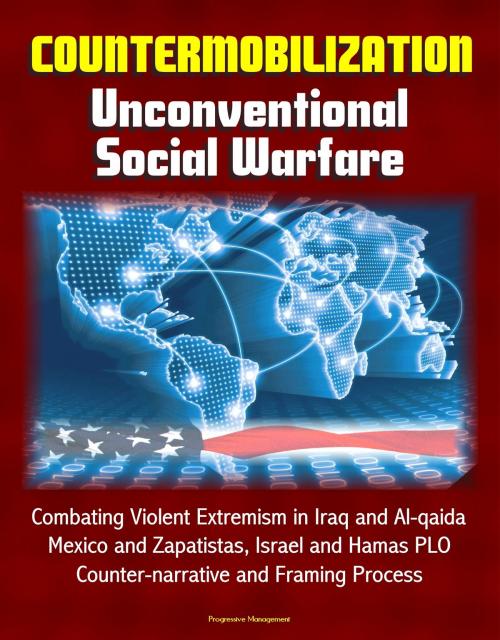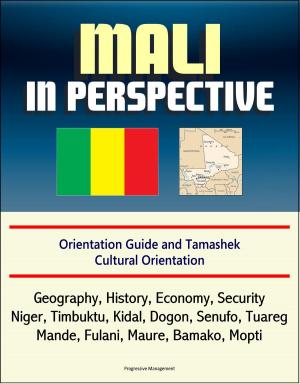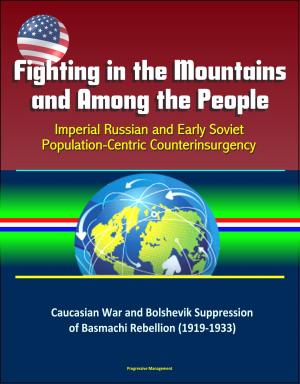Countermobilization: Unconventional Social Warfare - Combating Violent Extremism in Iraq and Al-qaida, Mexico and Zapatistas, Israel and Hamas PLO, Counter-narrative and Framing Process
Nonfiction, History, Middle East, Israel, Military| Author: | Progressive Management | ISBN: | 9781310872501 |
| Publisher: | Progressive Management | Publication: | April 18, 2015 |
| Imprint: | Smashwords Edition | Language: | English |
| Author: | Progressive Management |
| ISBN: | 9781310872501 |
| Publisher: | Progressive Management |
| Publication: | April 18, 2015 |
| Imprint: | Smashwords Edition |
| Language: | English |
Professionally converted for accurate flowing-text e-book format reproduction, this study examines the factors associated with effective social countermobilization against violent extremism. Understanding such factors can help a state develop a sponsored countermovement to protect its national interests against violent extremist movements. It attempts to provide a strategy and framework by which to defeat violent extremist movements through the use of unconventional warfare techniques.
Literature exists on how social movements come into existence and how they succeed or fail based upon how they initially mobilize or how they gain and maintain popular support, but very little information exists on incorporating this theoretical analysis with unconventional warfare and counterterrorism techniques. The first major body of thought that informs the concept of countermobilization is social movement theory. This area of study is pertinent, because my research works under the theory that terrorism and insurgencies are just forms or different levels of violent movements. Social movements can be defined as "'collective challenges' by people with common purposes and solidarity in sustained interactions with elites, opponents and authorities." Social movements can encompass broad objectives such as regional control, regime change, or global dominance, or they may represent narrow-based movements that may not even seek regime change. In either instance these movements must deal with elites, opponents, and/or authorities in order to reach their respective objectives, but in order to reach a level where a movement can interact with elites and authorities it must first mobilize into collective action.
CHAPTER I * INTRODUCTION * A. LITERATURE * B. THEORETICAL FRAMEWORK * 1. Expanding Political Opportunity * 2. "Complex" Organizational Strength * 3. Counter-narrative and Framing * C. CASE STUDIES * 1. Case Study: Iraq (Sons of Iraq—AQI) * 2. Case Study: Mexico (Zapatista—Anti-Zapatistas) * 3. Case Study: Israel (Hamas—Palestinian Liberation Organization) * CHAPTER II * CASE STUDY 1: IRAQ (SONS OF IRAQ—AL-QA'IDA) * A. BACKGROUND * B. EXPANDING POLITICAL OPPORTUNITIES * C. ORGANIZATIONAL STRUCTURE * D. COUNTER-NARRATIVE AND FRAMING PROCESS * E. UNITED STATES AND SOI * F. FINDINGS * CHAPTER III * CASE STUDY 2: MEXICO (ZAPATISTAS—ANTI-ZAPATISTAS MOVEMENT) * A. BACKGROUND * B. EXPANDING POLITICAL OPPORTUNITIES * C. ORGANIZATIONAL STRUCTURE * D. COUNTER-NARRATIVE AND FRAMING PROCESS * E. FINDINGS * CHAPTER IV * CASE STUDY 3: ISRAEL (HAMAS—PALESTINIAN LIBERATION ORGANIZATION) * A. BACKGROUND * B. EXPANDING POLITICAL OPPORTUNITY * C. ORGANIZATIONAL STRUCTURE * D. COUNTER-NARRATIVE AND FRAMING PROCESS * E. ISRAEL AND HAMAS * F. FINDINGS * CHAPTER V * COUNTERMOBILIZATION AND THE AL-QA'IDA VIOLENT EXTREMIST MOVEMENT * A. AL-QA'IDA AND THE POLITICAL PROCESS MODEL * B. COUNTER-MOBILIZATION AND AL-QA'IDA * C. CONCLUSION
Professionally converted for accurate flowing-text e-book format reproduction, this study examines the factors associated with effective social countermobilization against violent extremism. Understanding such factors can help a state develop a sponsored countermovement to protect its national interests against violent extremist movements. It attempts to provide a strategy and framework by which to defeat violent extremist movements through the use of unconventional warfare techniques.
Literature exists on how social movements come into existence and how they succeed or fail based upon how they initially mobilize or how they gain and maintain popular support, but very little information exists on incorporating this theoretical analysis with unconventional warfare and counterterrorism techniques. The first major body of thought that informs the concept of countermobilization is social movement theory. This area of study is pertinent, because my research works under the theory that terrorism and insurgencies are just forms or different levels of violent movements. Social movements can be defined as "'collective challenges' by people with common purposes and solidarity in sustained interactions with elites, opponents and authorities." Social movements can encompass broad objectives such as regional control, regime change, or global dominance, or they may represent narrow-based movements that may not even seek regime change. In either instance these movements must deal with elites, opponents, and/or authorities in order to reach their respective objectives, but in order to reach a level where a movement can interact with elites and authorities it must first mobilize into collective action.
CHAPTER I * INTRODUCTION * A. LITERATURE * B. THEORETICAL FRAMEWORK * 1. Expanding Political Opportunity * 2. "Complex" Organizational Strength * 3. Counter-narrative and Framing * C. CASE STUDIES * 1. Case Study: Iraq (Sons of Iraq—AQI) * 2. Case Study: Mexico (Zapatista—Anti-Zapatistas) * 3. Case Study: Israel (Hamas—Palestinian Liberation Organization) * CHAPTER II * CASE STUDY 1: IRAQ (SONS OF IRAQ—AL-QA'IDA) * A. BACKGROUND * B. EXPANDING POLITICAL OPPORTUNITIES * C. ORGANIZATIONAL STRUCTURE * D. COUNTER-NARRATIVE AND FRAMING PROCESS * E. UNITED STATES AND SOI * F. FINDINGS * CHAPTER III * CASE STUDY 2: MEXICO (ZAPATISTAS—ANTI-ZAPATISTAS MOVEMENT) * A. BACKGROUND * B. EXPANDING POLITICAL OPPORTUNITIES * C. ORGANIZATIONAL STRUCTURE * D. COUNTER-NARRATIVE AND FRAMING PROCESS * E. FINDINGS * CHAPTER IV * CASE STUDY 3: ISRAEL (HAMAS—PALESTINIAN LIBERATION ORGANIZATION) * A. BACKGROUND * B. EXPANDING POLITICAL OPPORTUNITY * C. ORGANIZATIONAL STRUCTURE * D. COUNTER-NARRATIVE AND FRAMING PROCESS * E. ISRAEL AND HAMAS * F. FINDINGS * CHAPTER V * COUNTERMOBILIZATION AND THE AL-QA'IDA VIOLENT EXTREMIST MOVEMENT * A. AL-QA'IDA AND THE POLITICAL PROCESS MODEL * B. COUNTER-MOBILIZATION AND AL-QA'IDA * C. CONCLUSION















